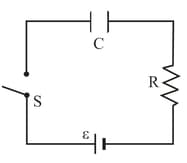As a parallel-plate capacitor with circular plates in diameter is being charged, the current density of the displacement current in the region between the plates is uniform and has a magnitude of Calculate the magnitude of the magnetic field at a distance from the axis of symmetry of this region. Calculate in this region.

Important Questions on Electromagnetic Waves
A silver wire has resistivity and a cross-sectional area of . The current in the wire is uniform and changing at the rate of When the current is .
What is the magnitude of the (uniform) electric field in the wire when the current in the wire is?
What is the displacement current in the wire at that time?
What is the ratio of the magnitude of the magnetic field due to the displacement current to that due to the current at a distance from the wire?
The circuit in the figure consists of switch , a ideal battery, a resistor and an air-filled capacitor. The capacitor has parallel circular plates of radius separated by At time switch is closed to begin charging the capacitor. The electric field between the plates is uniform. At what is the magnitude of the magnetic field within the capacitor, at a radial distance

Consider the situation of the previous problem. Define displacement resistance of the space between the plates where is the potential difference between the plates and is the displacement current. Show that varies with time as .
Previous problem: A parallel-plate capacitor having plate-area and plate separation is joined to a battery of emf and internal resistance at . Consider a plane surface of area , parallel to the plates and situated symmetrically between them. Find the displacement current through this surface as a function of time.
A point charge is moving along a straight line with a constant velocity . Consider a small area perpendicular to the direction of motion of the charge. Calculate the displacement current through the area when its distance from the charge is . The value of is not large so that the electric field at any instant is essentially given by Coulomb's law

